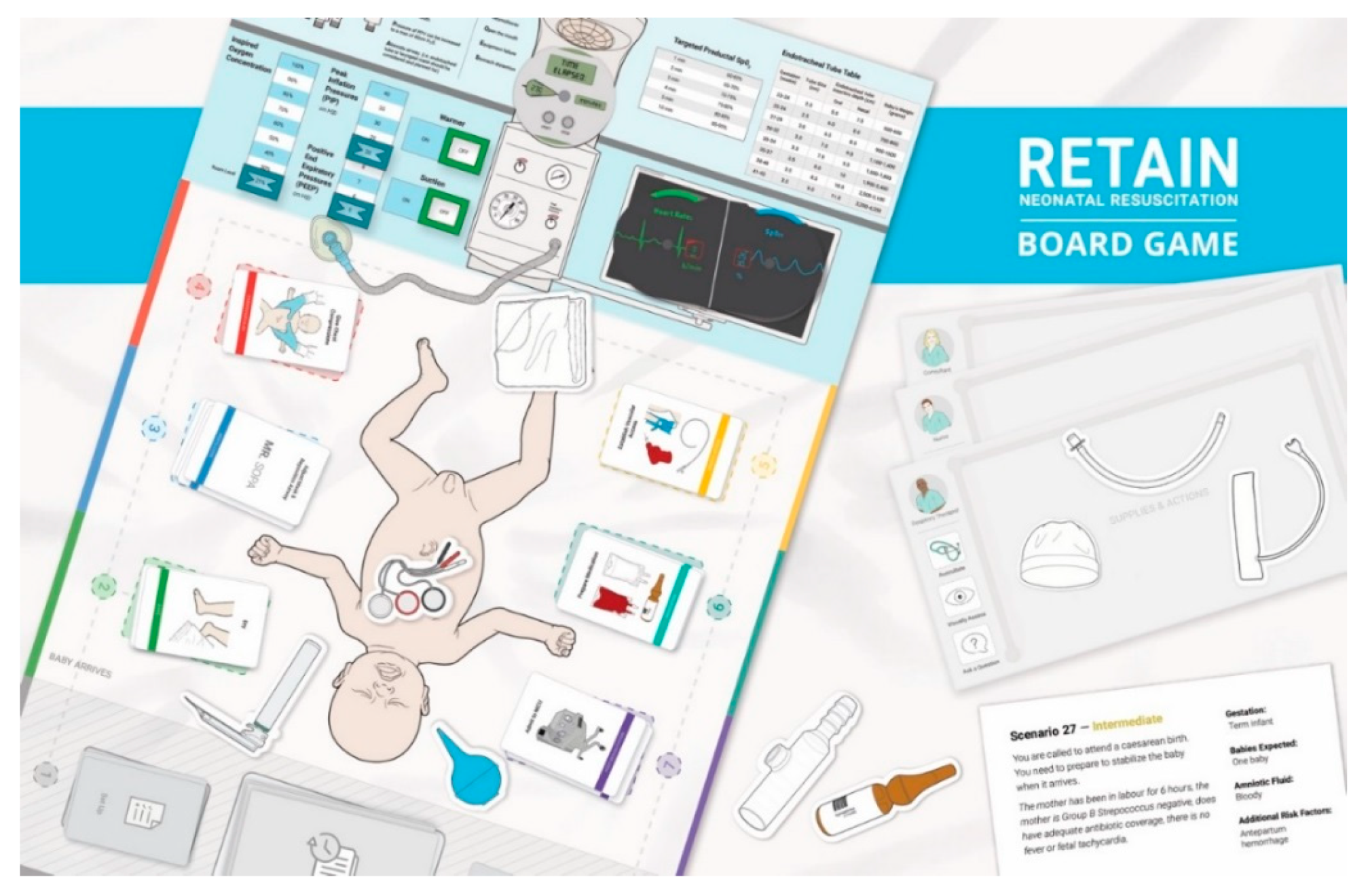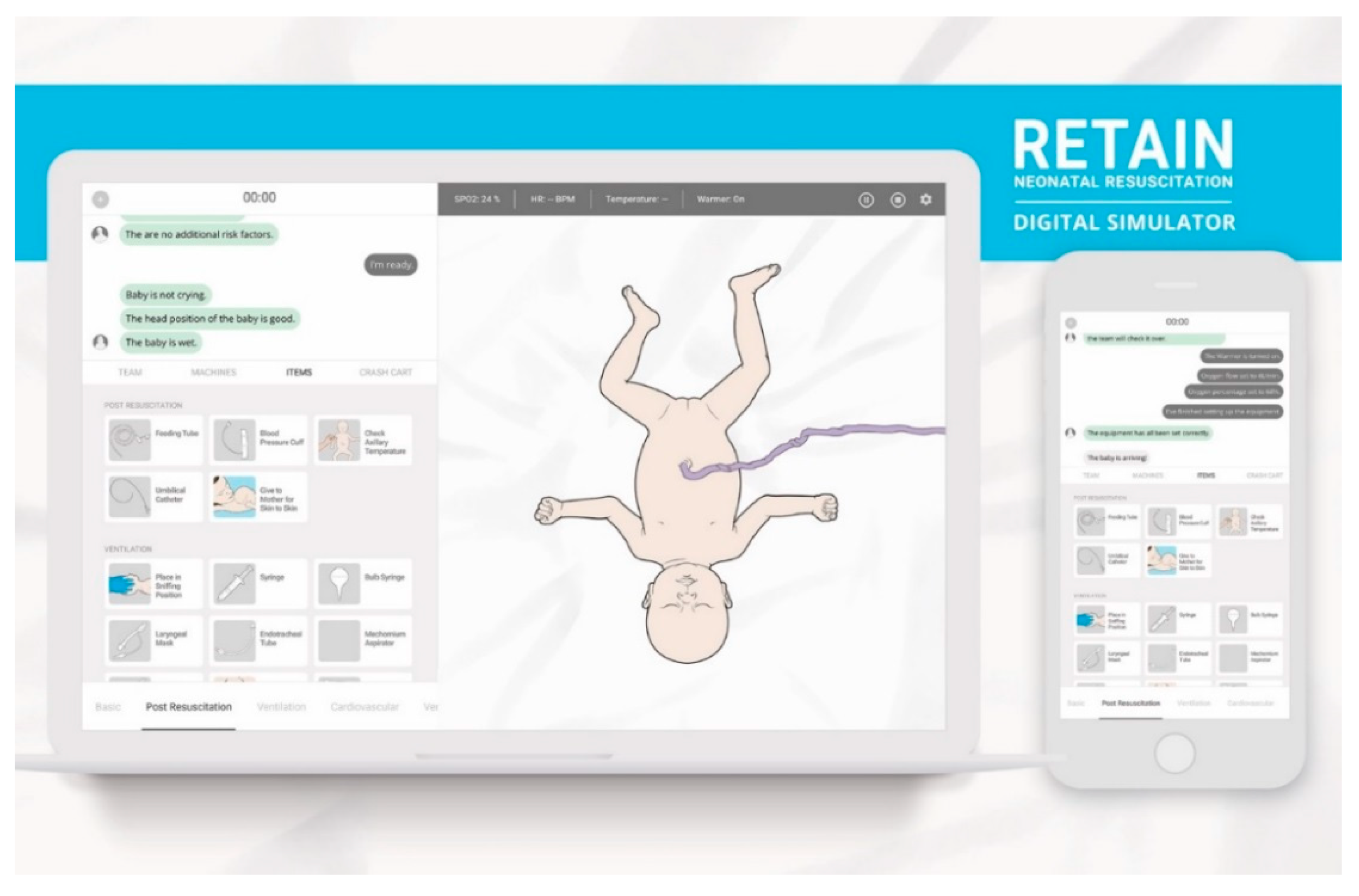The RETAIN Simulation-Based Serious Game—A Review of the Literature
Abstract
:1. Introduction
2. Methods
RETAIN (REsuscitation TrAINing)
3. Results
3.1. Preliminary Evaluation
3.2. Knowledge Improvement and Knowledge Retention
3.3. Growth Mindset-Moderated Performance
3.4. Application as a Summative Assessment
4. Discussion
Limitations
5. Conclusions
Author Contributions
Funding
Conflicts of Interest
Abbreviations
References
- Annual Number of Births. Available online: http://data.un.org/Data.aspx?d=SOWC&f=inID%3A75 (accessed on 24 May 2019).
- Weiner, G.M. Textbook of Neonatal Resuscitation (NRP), 7th ed.; Zaichkin, J., Ed.; American Academy of Pediatrics: Elk Grove Village, IL, USA, 2016; ISBN 978-1-61002-024-4. [Google Scholar]
- The Joint Commission. Sentinel event alert: Preventing infant death and injury during delivery. Sentin. Alert 2004, 30, 1–3. [Google Scholar]
- Institute of Medicine. Crossing the Quality Chasm: A New Health System for the 21th Century; National Academy Press: Washington, DC, USA, 2001. [Google Scholar]
- Zaichkin, J.; McCarney, L.; Weiner, G. NRP 7th Edition: Are You Prepared? Neonatal Netw. 2016, 35, 184–191. [Google Scholar] [CrossRef] [PubMed]
- Matterson, H.H.; Szyld, D.; Green, B.R.; Howell, H.B.; Pusic, M.V.; Mally, P.V.; Bailey, S.M. Neonatal resuscitation experience curves: Simulation based mastery learning booster sessions and skill decay patterns among pediatric residents. J. Perinat. Med. 2018, 46, 934–941. [Google Scholar] [CrossRef] [PubMed]
- Mileder, L.P.; Urlesberger, B.; Schwindt, J.; Simma, B.; Schmölzer, G.M. Compliance with Guidelines Recommending the Use of Simulation for Neonatal and Infant Resuscitation Training in Austria. Klin. Padiatr. 2014, 226, 24–28. [Google Scholar] [CrossRef]
- Binotti, M.; Genoni, G.; Rizzollo, S.; De Luca, M.; Carenzo, L.; Monzani, A.; Ingrassia, P.L. Simulation-based medical training for paediatric residents in Italy: A nationwide survey. BMC Med. Educ. 2019, 19, 1–7. [Google Scholar] [CrossRef]
- Bellotti, F.; Berta, R.; De Gloria, A. Designing effective serious games: Opportunities and challenges for research. Int. J. Emerg. Technol. Learn. 2010, 5, 22–35. [Google Scholar] [CrossRef] [Green Version]
- Graafland, M.; Schraagen, J.; Schijven, M. Systematic review of serious games for medical education and surgical skills training. Br. J. Surg. 2012, 99, 1322–1330. [Google Scholar] [CrossRef]
- Ghoman, S.K.; Patel, S.D.; Cutumisu, M.; von Hauff, P.; Jeffery, T.; Brown, M.R.G.; Schmölzer, G.M. Serious games, a game changer in teaching neonatal resuscitation? A review. Arch. Dis. Child. Fetal Neonatal Ed. 2019, 105, 98–107. [Google Scholar] [CrossRef] [Green Version]
- RETAIN Labs Medical Inc. RETAIN Neonatal Resuscitation. Available online: https://www.playretain.com/ (accessed on 30 November 2019).
- Cutumisu, M.; Patel, S.D.; Brown, M.R.G.; Fray, C.; von Hauff, P.; Jeffery, T.; Schmölzer, G.M. RETAIN: A board game that improves neonatal resuscitation knowledge retention. Front. Pediatr. 2019, 7, 13. [Google Scholar] [CrossRef] [Green Version]
- Cutumisu, M.; Brown, M.R.G.; Fray, C.; Schmölzer, G.M. Growth Mindset Moderates the Effect of the Neonatal Resuscitation Program on Performance in a Computer-Based Game Training Simulation. Front. Pediatr. 2018, 6, 195. [Google Scholar] [CrossRef] [Green Version]
- Kolb, D.A. Experiential Learning: Experience as the Source of Learning and Development; Prentice-Hall: Englewood Cliffs, NJ, USA, 1984; Volume 1. [Google Scholar]
- Ranchhod, A.; Gurǎu, C.; Loukis, E.; Trivedi, R. Evaluating the educational effectiveness of simulation games: A value generation model. Inf. Sci. 2014, 264, 75–90. [Google Scholar] [CrossRef]
- Ghoman, S.K.; Cutumisu, M.; Schmölzer, G.M. RETAIN board game as a summative assessment tool of healthcare professionals’ neonatal resuscitation knowledge. In Proceedings of the Pediatric Academic Societies, Baltimore, MD, USA, 27–30 April 2019. [Google Scholar]
- Bulitko, V.; Hong, J.; Kumaran, K.; Swedberg, I.; Thoang, W.; Von Hauff, P.; Schmölzer, G. RETAIN: A Neonatal Resuscitation Trainer Built in an Undergraduate Video-Game Class. arXiv 2015, arXiv:1507.00956. [Google Scholar]
- Mangels, J.; Butterfield, B.; Lamb, J.; Good, C.; Dweck, C. Why do beliefs about intelligence influence learning success? A social cognitive neuroscience model. Soc. Cognit. Affect. Neurosci. 2006, 1, 75–86. [Google Scholar] [CrossRef] [PubMed] [Green Version]
- Martin, A. Implicit theories about intelligence and growth (personal best) goals: Exploring reciprocal relationships. Br. J. Educ. Psychol. 2015, 85, 207–223. [Google Scholar] [CrossRef]
- Yüksel, H.S.; Gündüz, N. Formative and Summative Assessment in Higher Education: Opinions and Practices of Instructors. Eur.J. Educ. Stud. 2017, 3. [Google Scholar] [CrossRef]
- Verschueren, S.; Buffel, C.; Stichele, G. Vander Developing theory-driven, evidence-based serious games for health: Framework based on research community insights. J. Med. Internet Res. 2019, 21, 1–16. [Google Scholar]
- Tan, J.W.; Zary, N. Diagnostic markers of user experience, play, and learning for digital serious games: A conceptual framework study. J. Med. Internet Res. 2019, 21, 1–11. [Google Scholar] [CrossRef]
- Swiderska, N.; Thomason, E.; Hart, A.S.B. Randomised controlled trial of the use of an educational board game in neonatology. Med. Teach. 2013, 35, 413–415. [Google Scholar] [CrossRef]
- Lunze, K.; Bloom, D.; Jamison, D.; Hamer, D. The global burden of neonatal hypothermia: Systematic review of a major challenge for newborn survival. BMC Med. 2013, 11, 24. [Google Scholar] [CrossRef] [Green Version]
- Laptook, A.; Watkinson, M. Temperature management in the delivery room. Semin. Fetal Neonatal Med. 2008, 13, 383–391. [Google Scholar] [CrossRef]
- McCarthy, L.; Morley, C.; Davis, P.; Kamlin, C.; O’Donnell, C. Timing of interventions in the delivery room: Does reality compare with neonatal resuscitation guidelines? J. Pediatr. 2013, 163, 1553–1557. [Google Scholar] [CrossRef] [PubMed]
- Paige, J.T.; Arora, S.; Fernandez, G.; Seymour, N. Debriefing 101: Training faculty to promote learning in simulation-based training. Am. J. Surg. 2015, 209, 126–131. [Google Scholar] [CrossRef] [PubMed]


| Reference | Participants | Objectives | Study Design | Outcome |
|---|---|---|---|---|
| Board Game | ||||
| Cutumisu et. al 2019 [13] | 30 neonatal HCPs | Improves short-term knowledge retention | Compared HCPs’ performance on a written simulation scenario before and after playing the game | HCPs knowledge of the correct steps of neonatal resuscitation improved by 12%; biggest improvement in steps of temperature management |
| Ghoman et. al 2019 [17] | 20 neonatal HCPs | Functional as a summative assessment tool | Compared HCPs’ performance on a written simulation scenario to performance on the game | HCPs performed better on the game compared to a traditional assessment, and enjoyed |
| Computer Game | ||||
| Bulitko et. al 2015 [18] | Game developers, computer science students, and two neonatologists | Development and Pilot testing | Preliminary observational data collection and pilot play testing sessions of the game | The game was reported as well-received, eliciting stress, clinically valid, engaging, and useful for basic neonatal resuscitation training |
| Cutumisu et. al 2018 [14] | 50 neonatal HCPs | Effect of mindset in moderating performance | Analyzed HCPs’ time elapsed since NRP-training, self-reported growth mindset, and performance on the game | Time since last NRP course predicted number of tries needed to successfully complete the game when moderated by mindset; HCPs with higher growth mindset made fewer mistakes |
© 2019 by the authors. Licensee MDPI, Basel, Switzerland. This article is an open access article distributed under the terms and conditions of the Creative Commons Attribution (CC BY) license (http://creativecommons.org/licenses/by/4.0/).
Share and Cite
Ghoman, S.K.; Schmölzer, G.M. The RETAIN Simulation-Based Serious Game—A Review of the Literature. Healthcare 2020, 8, 3. https://doi.org/10.3390/healthcare8010003
Ghoman SK, Schmölzer GM. The RETAIN Simulation-Based Serious Game—A Review of the Literature. Healthcare. 2020; 8(1):3. https://doi.org/10.3390/healthcare8010003
Chicago/Turabian StyleGhoman, Simran K., and Georg M. Schmölzer. 2020. "The RETAIN Simulation-Based Serious Game—A Review of the Literature" Healthcare 8, no. 1: 3. https://doi.org/10.3390/healthcare8010003
APA StyleGhoman, S. K., & Schmölzer, G. M. (2020). The RETAIN Simulation-Based Serious Game—A Review of the Literature. Healthcare, 8(1), 3. https://doi.org/10.3390/healthcare8010003





